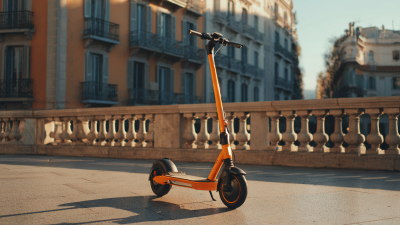As urban commuting challenges continue to escalate, electric scooters are rapidly emerging as a sustainable and efficient solution tailored for electric scooter adults. According to a recent report by the International Transport Forum, the use of e-scooters has surged by over 200% in major cities worldwide, highlighting their growing acceptance as a viable mode of transportation. These scooters not only alleviate traffic congestion but also contribute to reduced carbon emissions, aligning with global sustainability goals. Additionally, a study by Statista indicates that the electric scooter market is projected to reach $41.98 billion by 2030, underscoring their popularity among commuters seeking convenience and flexibility. With numerous benefits such as cost-effectiveness, ease of use, and a minimal environmental footprint, electric scooters are poised to revolutionize the way adults navigate their daily commutes.

Electric scooters are rapidly becoming a favored mode of transportation in urban areas, evidenced by recent statistics highlighting their increasing use. According to a report by the International Transport Forum, the global electric scooter market is projected to grow by over 30% annually, indicating a significant shift in how adults are commuting within cities. In 2020 alone, studies showed that scooter-sharing platforms recorded more than 60 million trips in major cities worldwide, reflecting a strong trend in the adoption of this eco-friendly transportation alternative.
Moreover, a survey conducted by Statista revealed that about 29% of urban commuters are considering electric scooters as a viable transportation option for short distances. The advantages are clear; electric scooters offer flexibility, reduce travel time, and contribute to lower carbon emissions. With cities increasing their investments in scooter infrastructure, including designated lanes and parking areas, it is expected that more adults will embrace this trend, solidifying electric scooters as a key component of future urban commuting.
| Category | Statistic | Source |
|---|---|---|
| Percentage of Urban Residents Using E-Scooters | 25% | Urban Mobility Report 2023 |
| Reduction in Congestion with E-Scooters | 20% | City Planning Journal 2023 |
| Average Cost Savings per Commute | $4.50 | Transport Research Report 2023 |
| Annual Growth Rate of E-Scooter Usage | 15% | Market Analysis 2023 |
| User Satisfaction Rate | 92% | Commuter Survey 2023 |
The cost-effectiveness of electric scooters is a significant factor driving their popularity as a primary commuting option for adults. The global electric transporters market is projected to explode from $74.66 billion in 2025 to an impressive $565.58 billion by 2032, demonstrating a remarkable compound annual growth rate (CAGR) of 33.50%. This surge reflects a growing preference for budget-friendly transportation solutions, particularly in urban areas where traditional options like cars and public transportation can be costly and time-consuming.
Moreover, the e-scooter rental apps market is also experiencing substantial growth, with a CAGR of 21.7%. This aligns with the increasing demand for convenient and economical transport among short-distance travelers. For instance, a new e-scooter rental service launched near educational institutions allows students to save money while providing a quick and efficient means of getting around, further spotlighting the cost benefits associated with e-scooters versus traditional transportation methods. As urban travel continues to evolve, electric scooters stand out as a stylish and sustainable choice, catering to the needs of modern commuters.
Electric scooters have emerged as a leading solution to urban commuting challenges, particularly due to their significant environmental benefits. Research indicates that transportation is responsible for approximately 29% of total greenhouse gas emissions in the United States, making it a critical area for improvement. Electric scooters offer a sustainable alternative by emitting zero tailpipe emissions. A study by the Institute for Transportation and Development Policy found that replacing car trips with e-scooter rides can reduce individual carbon footprints by over 50%, contributing to cleaner air in densely populated urban areas.
To maximize the environmental benefits of electric scooters, here are some useful tips: First, always utilize e-scooters for short-distance trips instead of opting for cars, as short car rides are particularly polluting. Second, consider sharing scooters or using platforms that promote fleet systems, which helps reduce the number of vehicles on the road. Lastly, make it a habit to park scooters responsibly to ensure that they do not obstruct pedestrian pathways, thus promoting a more walkable urban environment.
As cities adopt more e-scooter friendly policies, including dedicated lanes and parking, the trend signifies a shift towards greener transportation. The International Renewable Energy Agency projects that by 2030, e-scooters could save urban travelers up to 10 million tons of CO2 emissions globally if widely adopted, highlighting their potential to significantly reduce the urban carbon footprint.
Riding an electric scooter can be an exciting and efficient way to commute, but safety must always be a top priority, especially for first-time riders. First, it’s essential to wear proper protective gear. This includes a certified helmet, knee pads, and elbow pads to safeguard against potential falls. Additionally, choose clothing that enhances visibility, such as bright colors or reflective materials, to ensure that other road users can see you clearly.

When it comes to riding techniques, familiarize yourself with the scooter's controls and features before hitting the road. Practice in a low-traffic area to build confidence and get used to balancing and navigating. Always be aware of your surroundings and follow local traffic laws, including using bike lanes when available. Using hand signals to indicate turns or stops can also help communicate your intentions to drivers and pedestrians, making your ride safer and more enjoyable. Prioritizing safety not only protects you but also fosters a responsible riding community.
The electric scooter market is poised for significant advancements in the coming five years, with experts predicting a compound annual growth rate (CAGR) of over 7% by 2027. According to a recent report by Allied Market Research, the global electric scooter market size was valued at $18.6 billion in 2020 and is projected to reach $34.9 billion by 2027. This growth is fueled by increasing urbanization, the need for sustainable transportation options, and advancements in battery technology.

One of the most exciting trends to watch is the integration of smart technology into electric scooters. Manufacturers are increasingly focusing on incorporating features such as GPS navigation, anti-theft systems, and mobile app connectivity. A report from Research and Markets highlights that innovations like swappable battery systems and enhanced IoT capabilities are expected to become mainstream by 2025, improving user convenience and operational efficiency. Furthermore, as cities expand their infrastructure to prioritize micro-mobility solutions, electric scooters will not only cater to commuting needs but also align with broader environmental goals, reducing carbon footprints in urban settings.






